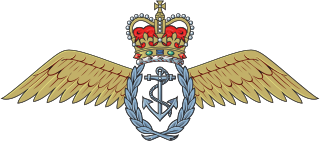
The Fleet Air Arm (FAA) is the naval aviation component of the United Kingdom's Royal Navy (RN). The FAA is one of five RN fighting arms. As of 2023 it is a predominantly "rotary" force, with helicopters undertaking roles once performed by biplanes such as the Fairey Swordfish. It operates the F-35 Lightning II for maritime strike and the AW159 Wildcat and AW101 Merlin for commando and anti-submarine warfare.

Aerobatics is the practice of flying maneuvers involving aircraft attitudes that are not used in conventional passenger-carrying flights. The term is a portmanteau of "aeroplane" and "acrobatics". Aerobatics are performed in aeroplanes and gliders for training, recreation, entertainment, and sport. Additionally, some helicopters, such as the MBB Bo 105, are capable of limited aerobatic manoeuvres. An example of a fully aerobatic helicopter, capable of performing loops and rolls, is the Westland Lynx.

The Army Air Corps (AAC) is the aviation arm of the British Army, first formed in 1942 during the Second World War by grouping the various airborne units of the British Army. Today, there are eight regiments of the AAC, as well as two independent flights and two independent squadrons deployed in support of British Army operations around the world. Regiments and flights are located in the United Kingdom, Kenya, and Canada. Some AAC squadrons provide the air assault elements of 16 Air Assault Brigade, through Joint Helicopter Command.

The Westland Wasp is a small 1960s British turbine-powered, shipboard anti-submarine helicopter. Produced by Westland Helicopters, it came from the same Saunders-Roe P.531 programme as the British Army Westland Scout, and is based on the earlier piston-engined Saunders-Roe Skeeter. It fulfilled the requirement of the Royal Navy for a helicopter small enough to land on the deck of a frigate and carry a useful load of two homing torpedoes.

Royal Naval Air Station Yeovilton, commonly referred to as RNAS Yeovilton, is an airbase of the Royal Navy, sited a few miles north of Yeovil, in the English county of Somerset. It is one of two active Fleet Air Arm bases, the other being RNAS Culdrose. RNAS Yeovilton is currently home to the Royal Navy Wildcat HMA2, along with Army Air Corps Wildcat AH1 helicopters, as well as the Royal Navy's Commando Helicopter Force Merlin HCi3/4/4A and Wildcat AH1 helicopters.
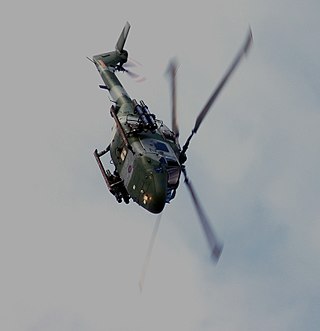
The Blue Eagles were the helicopter aerobatic team of the British Army Air Corps. It was one of only eight professional helicopter teams in the world, along with the Royal Navy Black Cats, Sarang of the Indian Air Force, the Scorpion aerobatic team of the Polish Air Force, Rotores de Portugal, the Patrulla Aspa of the Spanish Air Force, the Grasshoppers of the RNLAF and the US Army Silver Eagles. They were formed in the spring of 1968 by Air Corps instructors, and were established in the following years with five helicopters. In 2001, the team included the first British female military display pilot. In 2010, it was disbanded due to an ageing Westland Lynx fleet and financial cutbacks.

The Defence Helicopter Flying School (DHFS) was a military flying school based at RAF Shawbury in Shropshire, England. The school, established in 1997, was a tri-service organisation and trained helicopter aircrews for all three British armed forces. It initially used the Eurocopter Squirrel HT1 and Bell Griffin HT1 helicopters, which were retained despite the introduction of the Airbus Juno HT1 and Airbus Jupiter HT1.

The Wildcat Demo Team are the Royal Navy's helicopter aerobatics display team. The team is composed of two AgustaWestland Wildcat HMA.2 anti-submarine and anti-shipping helicopters, with the aircraft and crews drawn from 825 Naval Air Squadron, based at RNAS Yeovilton , in Somerset.

The Central Flying School (CFS) is the Royal Air Force's primary institution for the training of military flying instructors. Established in 1912 at the Upavon Aerodrome, it is the longest existing flying training school. The school was based at RAF Little Rissington from 1946 to 1976. Its motto is Imprimis Praecepta, Latin for "The Teaching is Everlasting".
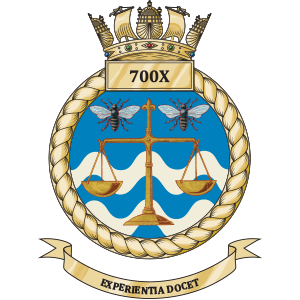
700 Naval Air Squadron is an experimental test squadron in the Royal Navy’s Fleet Air Arm.

847 Naval Air Squadron is a squadron of the Royal Navy Fleet Air Arm. It operates AgustaWestland Wildcat AH.1 helicopters and provides armed reconnaissance and light transport support to 3 Commando Brigade Royal Marines. Along with 845 and 846 naval air squadrons, it forms part of the Commando Helicopter Force. The squadron was re-formed from 3 Commando Brigade Air Squadron on 1 September 1995.

848 Naval Air Squadron was a squadron of the Royal Navy Fleet Air Arm. It operated the Westland Sea King HC.4 helicopter and previously provided advanced flying training to pilots for the other squadrons in the Commando Helicopter Force. The squadron was based at RNAS Yeovilton in Somerset and was decommissioned on 24 March 2016.
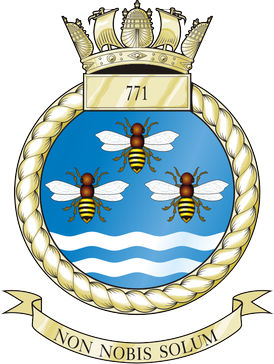
771 Naval Air Squadron of the Fleet Air Arm was formed on 24 May 1939 at HMS Daedalus, Lee-on-Solent as a Fleet Requirements Unit with 14 Fairey Swordfish TSR biplanes. The squadron carried out various exercises with ships and provided towed targets for naval air gunners, and was decommissioned on 22 March 2016.
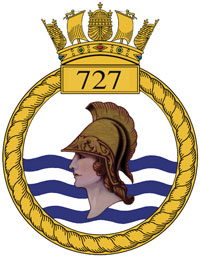
727 Naval Air Squadron is a squadron of the Royal Navy Fleet Air Arm. It was formed in 1943 as a Fleet Requirements Unit, being disbanded in December 1944. It was reformed twice in the 1940s and 1950s to provide flying experience for naval officers. The current squadron was created on 6 Dec 2001 from the Royal Naval Flying Training Flight. It operates the Grob Tutor, with its primary role to provide grading and legacy-Elementary Flying Training for Royal Navy and Royal Marine pilots under training. It also supports the Royal Navy's "Flying Start" flying scholarship scheme.
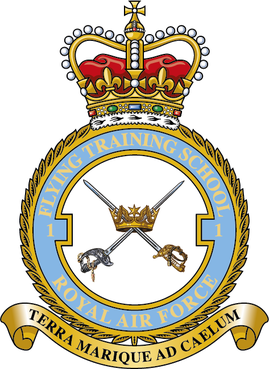
The No. 1 Flying Training School is the oldest military pilot training school in the world, currently used to deliver rotary training to aircrew of the British armed forces.

701 Naval Air Squadron was a Royal Navy Fleet Air Arm squadron, which last disbanded during September 1958 at RNAS Lee-on-Solent where it was a Helicopter Trials, Communications and Fleet Requirements Unit. It initially formed during July 1936 as a Catapult Flight operating out of Malta and routinely embarking in RN ships such as, HMS Barham, HMS Malaya, HMS Valiant and HMS Warspite. By autumn 1939 it was known as 701 Naval Air Squadron but disbanded in January 1940. It was active twice more during the Second World War, between May 1940 and June 1941 on special duties and then between October 1942 and August 1943 performing anti-submarine patrols. Reforming in April 1945 it was designated a Communications Unit, operating out of Heston until disbanding in 1947. It last reformed as a Fleet Requirements Unit at HMS Daedalus, Lee-on-Solent, during October 1957.
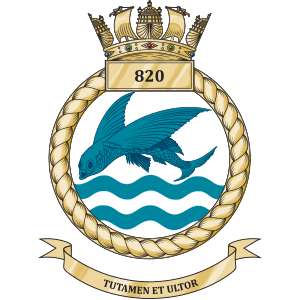
820 Naval Air Squadron is a Royal Navy Fleet Air Arm carrier-based squadron flying the AgustaWestland Merlin HM2 in Anti-Submarine and Airborne Early Warning (AEW) roles from RNAS Culdrose.

705 Naval Air Squadron was first formed as a flight in 1936 from No 447 Flight Royal Air Force and operated Swordfish torpedo bombers from battlecruisers. It achieved squadron status in 1939 before being disbanded in 1940. The squadron was re-formed briefly in 1945 and then again in 1947 as a fleet requirements unit to evaluate naval use of helicopters. Since the 1950s the squadron has been involved in the basic training of helicopter aircrew, and currently forms part of No. 1 Flying Training School at RAF Shawbury.

824 Naval Air Squadron is a Royal Navy Fleet Air Arm squadron based at RNAS Culdrose and currently operating the AgustaWestland Merlin HM2 Operational Conversion Unit. It trains aircrew in Anti-Submarine warfare and Airborne Surveillance and Control.

703 Naval Air Squadron of the Fleet Air Arm of the Royal Navy was formed as a long-range catapult squadron on 3 March 1942 at RNAS Lee-on-Solent. During the Cold War, it was reformed as an experimental trials unit, and then as a helicopter training squadron. Since 2003, the squadron has formed the Royal Naval wing of the Defence Elementary Flying Training School at RAF Barkston Heath.





















